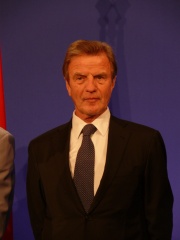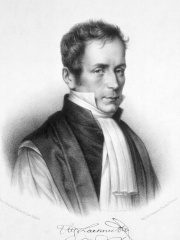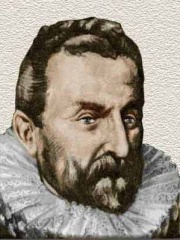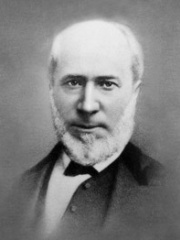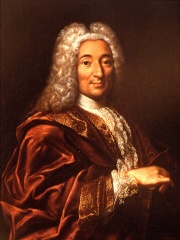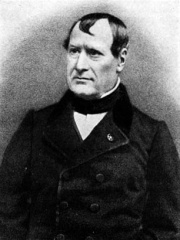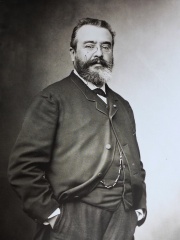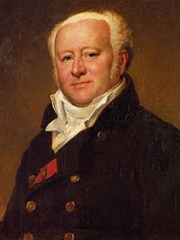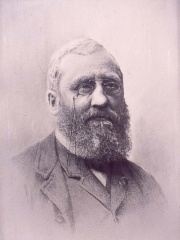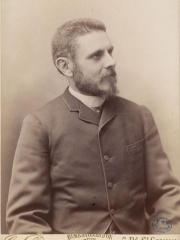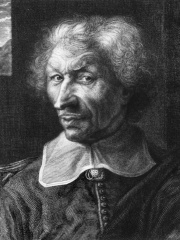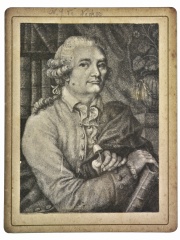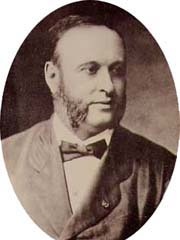
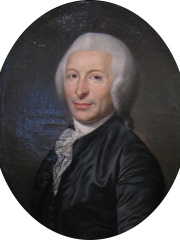

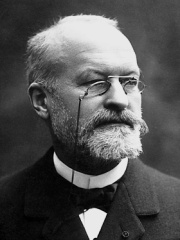
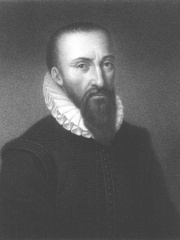
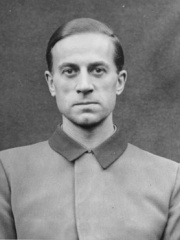
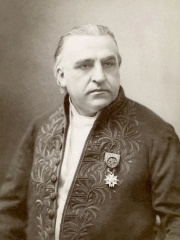
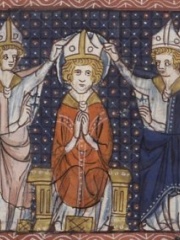
The Most Famous
PHYSICIANS from France
This page contains a list of the greatest French Physicians. The pantheon dataset contains 502 Physicians, 56 of which were born in France. This makes France the birth place of the 4th most number of Physicians behind United States and United Kingdom.
Top 10
The following people are considered by Pantheon to be the top 10 most legendary French Physicians of all time. This list of famous French Physicians is sorted by HPI (Historical Popularity Index), a metric that aggregates information on a biography’s online popularity. Visit the rankings page to view the entire list of French Physicians.

1. Albert Schweitzer (1875 - 1965)
With an HPI of 76.35, Albert Schweitzer is the most famous French Physician. His biography has been translated into 78 different languages on wikipedia.
Ludwig Philipp Albert Schweitzer (German: [ˈalbɛʁt ˈʃvaɪ̯t͡sɐ] ; 14 January 1875 – 4 September 1965) was an Alsatian polymath. He was a theologian, organist, musicologist, writer, humanitarian, philosopher, and physician. A Lutheran minister, Schweitzer challenged both the secular view of the historical Jesus as depicted by the historical-critical method current at this time, as well as the traditional Christian view. His contributions to the interpretation of Pauline Christianity concern the role of Paul's mysticism of "being in Christ" as primary and the doctrine of justification by faith as secondary. He received the 1952 Nobel Peace Prize for his philosophy of "Reverence for Life", becoming the eighth Frenchman to be awarded that prize. His philosophy was expressed in many ways, but most famously in founding and sustaining the Hôpital Albert Schweitzer in Lambaréné, French Equatorial Africa (now Gabon). As a music scholar and organist, he studied the music of German composer Johann Sebastian Bach and influenced the Organ Reform Movement (Orgelbewegung).

2. Joseph-Ignace Guillotin (1738 - 1814)
With an HPI of 70.71, Joseph-Ignace Guillotin is the 2nd most famous French Physician. His biography has been translated into 42 different languages.
Joseph-Ignace Guillotin (French: [ʒɔzɛf iɲas ɡijɔtɛ̃]; 28 May 1738 – 26 March 1814) was a French physician, politician, and freemason who proposed on 10 October 1789 the use of a device to carry out executions in France, as a less painful method of execution than existing methods. Although he did not invent the guillotine and opposed the death penalty, his name became an eponym for it. The actual inventor of the prototype was a man named Tobias Schmidt, working with the king's physician, Antoine Louis.

3. Alexis Carrel (1873 - 1944)
With an HPI of 69.50, Alexis Carrel is the 3rd most famous French Physician. His biography has been translated into 62 different languages.
Alexis Carrel (French: [alɛksi kaʁɛl]; 28 June 1873 – 5 November 1944) was a French surgeon and biologist who spent most of his scientific career in the United States. He was awarded the Nobel Prize in Physiology or Medicine in 1912 for pioneering vascular suturing techniques. He invented the first perfusion pump with Charles Lindbergh opening the way to organ transplantation. Carrel was also a pioneer in tissue culture, transplantology and thoracic surgery. He is known for his leading role in implementing eugenic policies in Vichy France.

4. Charles Louis Alphonse Laveran (1845 - 1922)
With an HPI of 68.97, Charles Louis Alphonse Laveran is the 4th most famous French Physician. His biography has been translated into 67 different languages.
Charles Louis Alphonse Laveran (18 June 1845 – 18 May 1922) was a French physician who won the Nobel Prize in Physiology or Medicine in 1907 for his discoveries of parasitic protozoans as causative agents of infectious diseases such as malaria and trypanosomiasis. Following his father, Louis Théodore Laveran, he took up military medicine as his profession. He obtained his medical degree from University of Strasbourg in 1867. At the outbreak of the Franco-Prussian War in 1870, he joined the French Army. At the age of 29 he became Chair of Military Diseases and Epidemics at the École de Val-de-Grâce. At the end of his tenure in 1878 he worked in Algeria, where he made his major achievements. He discovered that the protozoan parasite Plasmodium was responsible for malaria, and that Trypanosoma caused trypanosomiasis or African sleeping sickness. In 1894 he returned to France to serve in various military health services. In 1896 he joined Pasteur Institute as Chief of the Honorary Service, from where he received the Nobel Prize. He donated half of his Nobel prize money to establish the Laboratory of Tropical Medicine at the Pasteur Institute. In 1908, he founded the Société de Pathologie Exotique.Laveran was elected to French Academy of Sciences in 1893, and was conferred Commander of the National Order of the Legion of Honour in 1912.
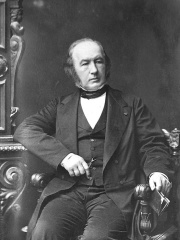
5. Claude Bernard (1813 - 1878)
With an HPI of 68.84, Claude Bernard is the 5th most famous French Physician. His biography has been translated into 52 different languages.
Claude Bernard (French: [bɛʁnaʁ]; 12 July 1813 – 10 February 1878) was a French physiologist. Historian I. Bernard Cohen of Harvard University called Bernard "one of the greatest of all men of science". He originated the term milieu intérieur, and the associated concept of homeostasis (the latter term being coined by Walter Cannon).

6. Ambroise Paré (1510 - 1590)
With an HPI of 68.70, Ambroise Paré is the 6th most famous French Physician. His biography has been translated into 42 different languages.
Ambroise Paré (c. 1510 – 20 December 1590) was a French barber surgeon who served in that role for kings Henry II, Francis II, Charles IX and Henry III. He is considered one of the fathers of surgery and modern forensic pathology and a pioneer in surgical techniques and battlefield medicine, especially in the treatment of wounds. He was also an anatomist, invented several surgical instruments, and was a member of the Parisian barber surgeon guild. In his personal notes about the care he delivered to Captain Rat, in the Piémont campaign (1537–1538), Paré wrote: Je le pansai, Dieu le guérit ("I bandaged him and God healed him"). This epitomises a philosophy that he used throughout his career. These words, inscribed on his statue in Laval, are reminiscent of the Latin adage medicus curat, natura sanat, "The physician cures, nature heals".

7. Karl Brandt (1904 - 1948)
With an HPI of 67.88, Karl Brandt is the 7th most famous French Physician. His biography has been translated into 39 different languages.
Karl Brandt (8 January 1904 – 2 June 1948) was a German physician and Schutzstaffel (SS) officer in Nazi Germany. Trained in surgery, Brandt joined the Nazi Party in 1932 and became Adolf Hitler's escort doctor in August 1934. A member of Hitler's inner circle at the Berghof, he was selected by Philipp Bouhler, the head of Hitler's Chancellery, to administer the Aktion T4 euthanasia program. Brandt was later appointed the Reich Commissioner of Sanitation and Health (Bevollmächtigter für das Sanitäts- und Gesundheitswesen). Accused of involvement in human experimentation and other war crimes, Brandt was indicted in late 1946 and faced trial before a U.S. military tribunal along with 22 others in United States of America v. Karl Brandt, et al. He was convicted, sentenced to death, and hanged on 2 June 1948.

8. Jean-Martin Charcot (1825 - 1893)
With an HPI of 67.64, Jean-Martin Charcot is the 8th most famous French Physician. His biography has been translated into 49 different languages.
Jean-Martin Charcot (French: [ʃaʁko]; 29 November 1825 – 16 August 1893) was a famous French neurologist and professor of anatomical pathology. He worked on groundbreaking work about hypnosis and hysteria, in particular with his hysteria patient Louise Augustine Gleizes. Charcot is known as "the founder of modern neurology", and his name has been associated with at least 15 medical eponyms, including various conditions sometimes referred to as Charcot diseases. Charcot has been referred to as "the father of French neurology and one of the world's pioneers of neurology". His work greatly influenced the developing fields of neurology and psychology; modern psychiatry owes much to the work of Charcot and his direct followers. He was the "foremost neurologist of late nineteenth-century France" and has been called "the Napoleon of the neuroses".

9. Hilary of Poitiers (315 - 367)
With an HPI of 67.63, Hilary of Poitiers is the 9th most famous French Physician. His biography has been translated into 54 different languages.
Hilary of Poitiers (Latin: Hilarius Pictaviensis; c. 310 – c. 367) was Bishop of Poitiers and a Doctor of the Church. He was sometimes referred to as the "Hammer of the Arians" (Malleus Arianorum) and the "Athanasius of the West". His name comes from the Latin word for happy or cheerful. In addition to his important work as bishop, Hilary was married and the father of Abra of Poitiers, a nun and saint who became known for her charity.
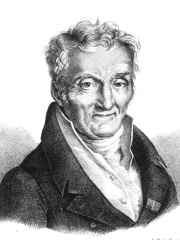
10. Philippe Pinel (1745 - 1826)
With an HPI of 67.38, Philippe Pinel is the 10th most famous French Physician. His biography has been translated into 33 different languages.
Philippe Pinel (French: [pinɛl]; 20 April 1745 – 25 October 1826) was a French physician, precursor of psychiatry and incidentally a zoologist. He was instrumental in the development of a more humane psychological approach to the custody and care of psychiatric patients, referred to today as moral therapy. He worked for the abolition of the shackling of mental patients by chains and, more generally, for the humanisation of their treatment. He also made notable contributions to the classification of mental disorders and has been described by some as "the father of modern psychiatry". After the French Revolution, Dr. Pinel changed the way we look at the mentally ill (or "aliénés", "alienated" in English) by claiming that they can be understood and cured. An 1809 description of a case that Pinel recorded in the second edition of his textbook on insanity is regarded by some as the earliest evidence for the existence of the form of mental disorder later known as dementia praecox or schizophrenia, although Emil Kraepelin is generally accredited with its first conceptualisation. "Father of modern psychiatry", he was credited with the first classification of mental illnesses. He had a great influence on psychiatry and the treatment of the alienated in Europe and the United States.
Pantheon has 56 people classified as physicians born between 315 and 1939. Of these 56, 1 (1.79%) of them are still alive today. The most famous living physicians include Bernard Kouchner. The most famous deceased physicians include Albert Schweitzer, Joseph-Ignace Guillotin, and Alexis Carrel. As of April 2022, 10 new physicians have been added to Pantheon including Édouard Séguin, Pierre Fauchard, and Jean Pierre Flourens.
Living Physicians
Go to all RankingsDeceased Physicians
Go to all Rankings
Albert Schweitzer
1875 - 1965
HPI: 76.35
Joseph-Ignace Guillotin
1738 - 1814
HPI: 70.71
Alexis Carrel
1873 - 1944
HPI: 69.50
Charles Louis Alphonse Laveran
1845 - 1922
HPI: 68.97
Claude Bernard
1813 - 1878
HPI: 68.84
Ambroise Paré
1510 - 1590
HPI: 68.70
Karl Brandt
1904 - 1948
HPI: 67.88
Jean-Martin Charcot
1825 - 1893
HPI: 67.64
Hilary of Poitiers
315 - 367
HPI: 67.63
Philippe Pinel
1745 - 1826
HPI: 67.38
René Laennec
1781 - 1826
HPI: 67.03
Jean Nicot
1530 - 1605
HPI: 65.47

Newly Added Physicians (2022)
Go to all Rankings
Édouard Séguin
1812 - 1880
HPI: 56.27
Pierre Fauchard
1679 - 1761
HPI: 53.79
Jean Pierre Flourens
1794 - 1867
HPI: 52.43
Adrien Proust
1834 - 1903
HPI: 52.31
Jean-Nicolas Corvisart
1755 - 1821
HPI: 50.89
Louis-Antoine Ranvier
1835 - 1922
HPI: 49.44
Pierre Marie
1853 - 1940
HPI: 49.26
Guy Patin
1601 - 1672
HPI: 47.83
Noël Martin Joseph de Necker
1730 - 1793
HPI: 47.81
Maurice Raynaud
1834 - 1881
HPI: 47.16

Which Physicians were alive at the same time? This visualization shows the lifespans of the 25 most globally memorable Physicians since 1700.

